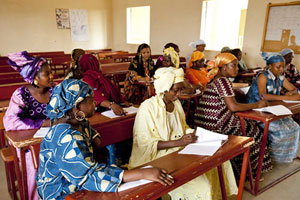Sources of funding
Private foundations
 Many private foundations in developing countries as well as developed countries are potential sources of funding, both for capital investments and for student scholarships (Wisconsin Medical Society n.d.). European foundations can be identified through the European Foundation Center, and North American foundations can be found through CharityNavigator.org. The Rockefeller Foundation, for example, has a long history of financing both capital investments in medical schools and student scholarships and fellowships (Jones and Rahman 2009).
Many private foundations in developing countries as well as developed countries are potential sources of funding, both for capital investments and for student scholarships (Wisconsin Medical Society n.d.). European foundations can be identified through the European Foundation Center, and North American foundations can be found through CharityNavigator.org. The Rockefeller Foundation, for example, has a long history of financing both capital investments in medical schools and student scholarships and fellowships (Jones and Rahman 2009).
Religious communities and institutions
Especially for faith-based schools, religious communities and institutions are a potentially large source of financing. Given their social mission and historical interests in health, many religious communities and institutions are quite willing to invest in the training of health workers.
Research funding
Research funding from external sources such as the US National Institutes for Health or the Wellcome Trust can be used to subsidize the salaries of faculty or the stipends of students who engage in research work (NIH Clinical Center n.d.). In addition, some of the facilities and equipment, such as laboratory space, purchased with research funding can also be used for teaching.
Scholarships
Student scholarships that are provided by governments, foundations, or private companies can pay directly for education (AMA n.d.). At the College of Medicine, University of Malawi, students with the top 20 premedical program entrance exam scores are given scholarships, provided that funding is available (SAMSS 2009). In addition, some countries compel private universities to offer scholarships to students in order to maintain their accreditation. For example, Mexico, Syria, and the Philippines have required private schools to give scholarships to a percentage of students to offer opportunities to low-income or needy students (Salmi and Hauptman 2006).
Student loans
Because health professional students will become some of the top earners in their countries on graduation, it is quite feasible for them to pay for a portion of their education. Student loans are currently not widely used in developing countries, mainly due to concerns over accountability in repayment. By connecting loan repayment to certification renewal or paying for loans directly out of recipient paychecks, this accountability can be increased and revolving loan funds can be established.
Tiered admission
In order to subsidize their students on school scholarships many schools, such as the medical school in Malawi, have started to accept students on a tiered basis. The most qualified students are given full scholarships, and other students who still meet admission criteria are admitted on a self-pay basis. The tuition paid by the self-pay students subsidizes the scholarships of the first tier of students. In some cases the second tier of students may be admitted from outside the country, as at the College of Medicine in Malawi (Muula 2009).
Tuition
For either public or private schools, tuition can be a major source of funding. For private schools, tuition is often the only source of funding, whereas in public schools, tuition is supplemented by funding from the Ministry of Health or the Ministry of Education. Tuition tends to have a variety of different sources, including the student’s extended family and income earned by students working as research assistants or in laboratories. Other sources of tuition funding include public and private loans as well as grants from public and private sources. In developing countries, the ability of the extended family to pay for a young person’s education should not be underestimated. Many families have at least one member who either has access to credit within the country or is a member of the global Diaspora. Such loans within the extended family are often expected to be paid back over time once the student graduates and starts to earn an income.
In addition to innovative sources of funding, there are a number of ways to produce cost efficiencies in schools and therefore do more with the same amount of funding. CapacityPlus is applying and refining a program for improving the management of health professional schools.

